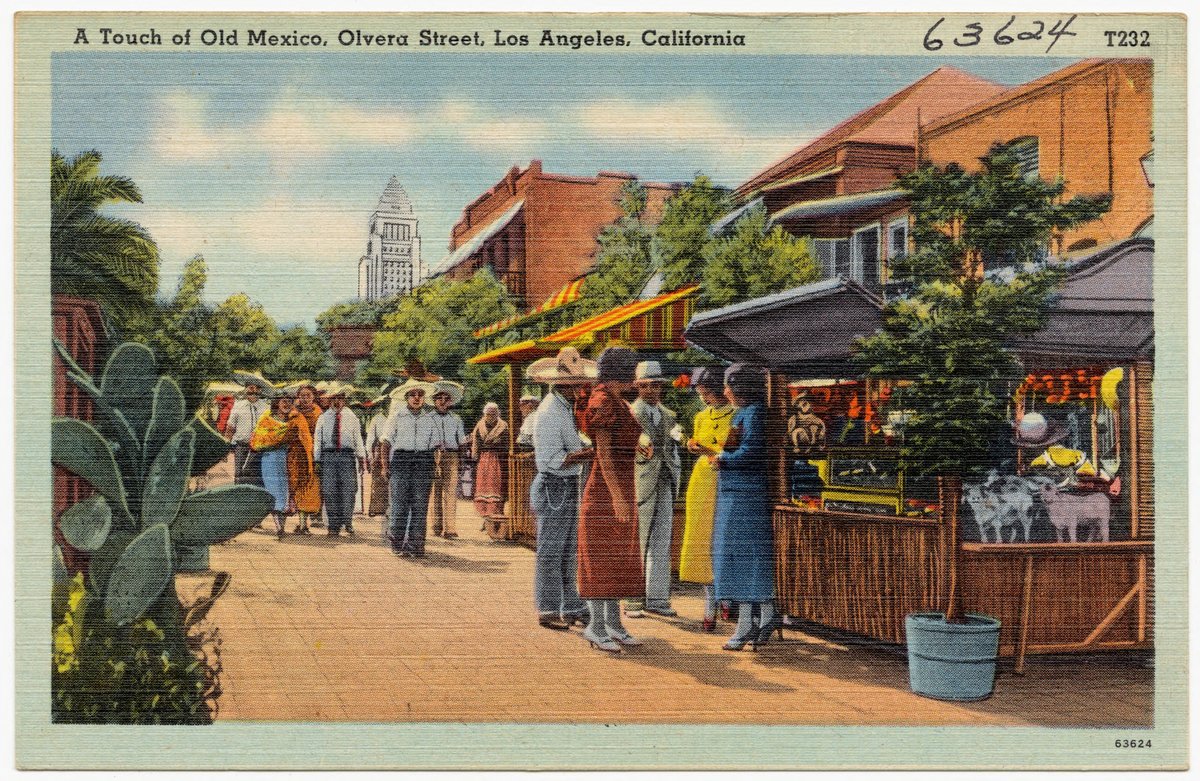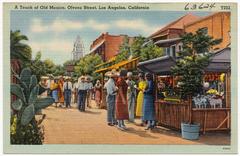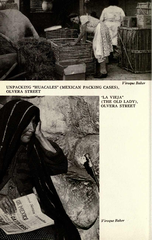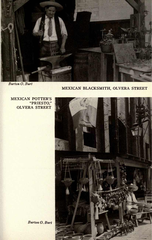
Olvera Street Visiting Hours, Tickets, and Los Angeles Historical Sites Guide
Date: 14/06/2025
Introduction
Olvera Street, nestled in the heart of downtown Los Angeles, is recognized as the “birthplace of Los Angeles” and stands as a living testament to the city’s multicultural origins. Established in 1781 by Spanish settlers, this bustling marketplace and historic district blends Mexican, Spanish, and indigenous influences, offering visitors a vibrant tapestry of tradition, architecture, and community life. Today, Olvera Street is both a celebration of Mexican-American heritage and a gateway to understanding the rich historical layers that shaped Los Angeles.
This comprehensive guide details Olvera Street’s visiting hours, ticketing information, transportation options, key attractions, accessibility, and practical tips. Whether you are a history buff, a lover of authentic Mexican culture, or simply seeking a unique Los Angeles experience, Olvera Street promises a rewarding journey through history and tradition.
For more resources and updated event information, visit the official El Pueblo de Los Angeles website, and explore nearby cultural landmarks including Union Station, Italian American Museum, and Chinese American Museum.
Table of Contents
- Introduction
- Historical Background
- Key Landmarks and Museums
- Practical Visitor Information
- Festivals and Community Events
- Dining and Marketplace Experiences
- Safety, Accessibility, and Travel Tips
- Frequently Asked Questions (FAQ)
- Conclusion
- References and Further Reading
Historical Background
Founding and Early History
Olvera Street traces its roots to 1781, when “Los Pobladores” established El Pueblo de la Reina de Los Ángeles in an area long inhabited by the Tongva/Gabrielino people (Secret Los Angeles; Noro.mx). Originally known as “Wine Street,” it was renamed in 1877 to honor Judge Agustin Olvera, a key figure in early Los Angeles history (PBS SoCal). Over the 19th century, the district grew into a social and commercial center, home to diverse communities and adobe dwellings.
Transformation and Preservation
By the early 20th century, Olvera Street faced decline. Preservationist Christine Sterling spearheaded a revitalization campaign, transforming it into a Mexican-style marketplace in 1930. This initiative preserved historic structures, encouraged traditional vendors, and established Olvera Street as a focal point for Mexican-American culture (El Pueblo LA; Olvera-Street.com).
Key Landmarks and Museums
- Avila Adobe: Constructed in 1818, Avila Adobe is the city’s oldest surviving residence. The museum features period furnishings and interprets early Californian domestic life (El Pueblo LA; Daytrippen).
- Sepulveda House: Built in 1887, this Victorian-style home reflects the transition from Mexican to American rule. Now a museum, it showcases 19th-century Los Angeles (Friendly Local Guides).
- Pico House: Erected between 1869 and 1870 by Pío Pico, the last Mexican governor of California, Pico House was the city’s first luxury hotel (Friendly Local Guides).
- Plaza Firehouse: Opened in 1884, this was Los Angeles’ first fire station and now exhibits historical firefighting equipment (El Pueblo LA).
- Old Plaza Church: Founded in 1822, this Spanish Colonial church is one of the city’s oldest religious landmarks (USA History Timeline).
- Italian American Museum & Chinese American Museum: Both housed within the El Pueblo district, these museums highlight the multicultural roots of Los Angeles (Daytrippen).
Practical Visitor Information
Visiting Hours
- Olvera Street Marketplace: Open daily, typically 10:00 am – 7:00 pm (hours may vary by season, event, or individual vendor; some sources cite 9:00 am – 4:00 pm or 10:00 am – 10:00 pm).
- Avila Adobe: Tuesday–Sunday, 10:00 am – 4:00 pm.
- Sepulveda House & Plaza Firehouse Museums: Wednesday–Sunday, 10:00 am – 4:00 pm.
- Pico House: Open during special events; check the official website.
Always consult the El Pueblo de Los Angeles Historic Monument website or individual museum sites for the latest hours.
Tickets and Admission
- Marketplace: Free entry.
- Museums: Most are free or request a nominal donation ($5 for adults, $3 for seniors/students, free for children under 12, where applicable).
- Guided Tours: Offered by the City of Los Angeles and other organizations, often by advance booking and with a fee.
Accessibility
- Pedestrian Friendly: Olvera Street is a pedestrian-only zone.
- Wheelchair Access: Most public spaces, restrooms, and museums are wheelchair accessible. Some historic structures may have limited access due to age; check specific venues.
- Restrooms: Accessible facilities are available throughout the district.
Parking and Transportation
- By Public Transit: Steps from Union Station, accessible via Metro Rail, Amtrak, Metrolink, and several bus lines.
- Parking: Multiple paid lots serve El Pueblo de Los Ángeles, with rates from $8–$20 per day (Way.com). Chinatown garages nearby may offer lower rates.
- Tip: Reserve parking in advance using online platforms, especially during festivals or weekends.
Festivals and Community Events
Olvera Street is home to some of Los Angeles’ most cherished cultural celebrations:
- Blessing of the Animals: Held the Saturday before Easter, this event features traditional blessings for pets and livestock (Discover Los Angeles).
- Día de los Muertos: Late October through November 2, with altars (ofrendas), music, processions, and traditional foods (USA History Timeline; Travel in USA).
- Las Posadas: A nine-day Christmas tradition with nightly processions, caroling, and piñatas (El Pueblo LA).
- Cinco de Mayo and Fiestas Patrias: Celebrating Mexican heritage with music, dance, and culinary specialties.
These festivals draw thousands and offer a profound immersion in Mexican-American tradition and community life.
Dining and Marketplace Experiences
Olvera Street’s marketplace is lined with over 30 stalls and eateries, many operated by families dating back to the 1930s:
- Cielito Lindo: Known for taquitos and avocado sauce (Daytrippen).
- Las Anitas, La Noche Buena, and El Paseo Inn: Serve classic Mexican dishes in historic settings.
- Street Vendors: Churros, tamales, aguas frescas, and Mexican candies abound (Travel in USA).
- Artisan Shops: Handcrafted pottery, textiles, leather goods, and papel picado.
Many vendors offer live demonstrations, giving insight into traditional craftsmanship (Travel in USA).
Safety, Accessibility, and Travel Tips
- Safety: The area is considered safe during the day and for most public events, but standard urban precautions apply (The Broke Backpacker).
- Weather: Los Angeles is sunny year-round. Bring sunscreen, a hat, and water, especially in summer.
- Best Time to Visit: Mornings or weekdays are less crowded; weekends and festivals are livelier but busier.
- Cash & Cards: Most vendors accept cards, but some small purchases may be cash-only.
- Photography: Respect privacy and always ask before photographing people or performances.
- Restrooms: Public restrooms are located within the El Pueblo complex.
Frequently Asked Questions (FAQ)
Q: What are Olvera Street’s visiting hours?
A: The marketplace is generally open daily from 10:00 am to 7:00 pm, but hours may vary by season or event.
Q: Is there an admission fee?
A: Entry to the marketplace is free. Museums are usually free or request a small donation.
Q: Are guided tours available?
A: Yes, guided tours are available for a fee and often require advance booking.
Q: Is Olvera Street accessible for people with disabilities?
A: Most of the area is accessible, but some historic buildings may have limitations.
Q: Where can I park?
A: Several public parking lots are nearby, as well as Union Station parking. Reserve in advance if possible.
Q: What is the best time to visit?
A: Early mornings and weekdays are quieter; festivals offer the most vibrant atmosphere.
Conclusion
Olvera Street is a must-visit destination for anyone seeking to experience Los Angeles’ deep-rooted multicultural heritage. From its historic adobe architecture and museums to its lively festivals and authentic Mexican marketplace, Olvera Street encapsulates the city’s spirit of community, resilience, and cultural celebration.
Plan your visit by checking current hours and event schedules, and make the most of your experience with a guided tour or by attending a festival. For more travel insights, download the Audiala app and follow us on social media. For more information and the latest updates, visit the El Pueblo de Los Angeles official site and explore nearby sites such as the Learn California and Secret Los Angeles.
References and Further Reading
- Friendly Local Guides - Olvera Street Fun Facts
- Secret Los Angeles - Olvera Street Virtual Tour
- PBS SoCal - Olvera Street: The Fabrication of L.A.’s Mexican Heritage
- Daytrippen - Olvera Street Los Angeles Day Trip
- Periodic Adventures - Avila Adobe & Olvera Street Guide
- El Pueblo de Los Angeles - Olvera Street
- Union Station LA - History
- Italian Hall - Italian American Museum
- CAMLA - Chinese American Museum
- Learn California - Placita Olvera
- Way.com - Olvera Street Parking Guide
- The Broke Backpacker - Is Los Angeles Safe?
- Travel in USA - Olvera Street

































































































































